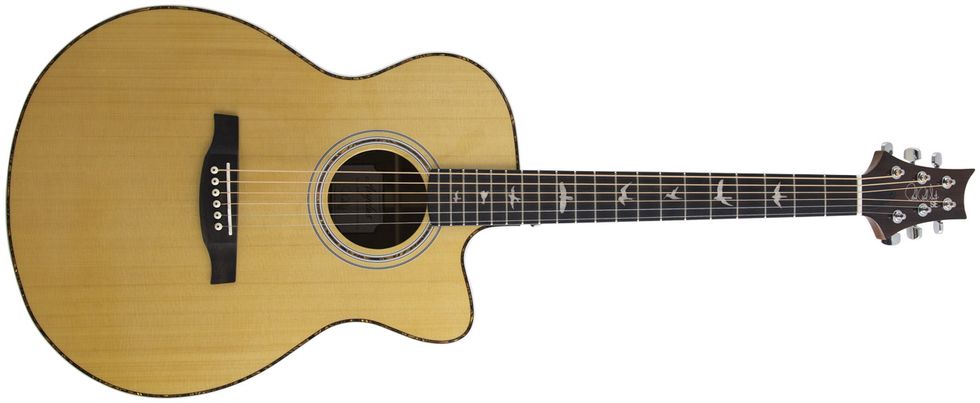RatingsPros:Nice-sounding acoustic-electric guitar that takes it cue from PRS’ pricey boutique line. Cons: Back and sides are laminated. Bass response could be better in open tunings. Street: $749 street PRS SE A40E prsguitars.com | Tones: Playability: Build/Design: Value: |
In the early 1990s, Paul Reed Smith teamed up with luthier Dana Bourgeois to work on acoustic guitar designs. The effort resulted in a handful of new steel-strings, but these instruments apparently didn’t satisfy what Smith wanted from an acoustic guitar, and they never went into production.
Smith, it seems, was never cured of the acoustic bug, and by 2009 PRS finally made a formal foray into the acoustic market with handcrafted models that attracted elite acoustic pickers, including Tony McManus and Martin Simpson. The guitars were expensive, but the body shapes and many other features were eventually adopted in the more accessibly priced SE series.
The acoustic SE line has flourished since its introduction five years ago and gained six new guitars in 2018. Three are based on PRS’ non-cutaway Tonare shape. The others use the handsome Angelus body shape, with its smooth cutaway. For this review, we checked out the Angelus A40E, and found it to be a super playable and sonically versatile flattop—particularly for players that spend more time with electrics.
Bracing Across the Ages
It might be relatively affordable, but the A40E is not dressed down in the slightest. The fretboard is decorated with PRS’ trademark bird inlays, and the purfling and rosette are made with an eye-catching copper-like acrylic, which contrasts nicely with the cream-colored body binding.
The guitar’s solid-spruce top is attractive, fine grained, and free from irregularities, as are the laminated ovangkol back and sides, with their subtle figuring. (Ovangkol, by the way, is an evergreen tree that grows abundantly in Western Africa, and is presently a more sustainable hardwood for backs and sides. It’s related to rosewood and shares some of that endangered species’ broad tonal spectrum and fast response.)
Under the hood, the A40E, like all PRS acoustics, deviates from traditional steel-string bracing. Instead of common X-bracing, the top is supported by hybrid pattern bracing which fuses X-bracing and classical-inspired fan-bracing concepts. It’s a system that PRS says was partly inspired by a particularly robust-sounding Torres guitar from the late 19th century.
Our review model is a very nicely built example. Fretwork and setup are all very clean. So is the high-gloss finish, though it can seem a little thick in places. There are hints of tooling marks and excess glue around the label. But these are minor and not altogether uncommon shortcomings for a guitar in this price range. And with the possible exception of the thick finish, they will not affect sound or playability.
An Attractive Voice
To my ear, the SE A40E, lives around the neutral end of the sonic spectrum, with strong fundamentals, but lacking some of the shimmering complexity that’s typical of, say, a solid rosewood- or mahogany-backed flattop of similar size.
There’s a very nice balance between the registers in standard tuning. And when strumming cowboy chords or closed jazz voicings, the guitar has an appealing punchiness that probably translates well in band contexts. Individual notes in flat-picked lines are round and full, but are also very well defined—qualities that translate well to fingerpicking. In alternate tunings like open G and DADGAD, I often longed for a little more power and response from the bottom end. On the other hand, as I got to know the guitar a little better, I detected a real sweetness in its midrange-oriented voice that might be obscured by too much extra low-end thump.
The SE A40E comes equipped with Fishman GT1 electronics, including an under-saddle transducer and a preamp that is mounted discretely under the top, with thumbwheel tone and volume controls on the bass side of the soundhole. This preamp is powered by a 9V battery concealed in a compartment at the endpin. Plugged into a Fender Acoustasonic amp, the guitar sounds natural, woody, and free of unwanted under-saddle quacking effects. On the whole the system is more than ample for a wide range of gigging applications.
Feeling Fast, Fat, and Silky Smooth
The SE A40E’s playability is superb—especially for electric guitarists that struggle with transitioning to acoustic. The neck shape is what PRS calls “Wide Fat.” And if a Gibson 1959 Les Paul reissue feels good to you, then you’ll feel at home on this guitar.
The SE A40E’s neck feels fast, and its low action makes it easy to play barre chords and fast single-note lines in all positions. I can even bend notes on the G string a whole step without great difficulty. And I can play the guitar for longer stretches without experiencing the fret-hand strain than I can on many other acoustics.
The Verdict
PRS’ SE A40E is an affordable guitar with a lot of upside. It’s an interesting and well-executed design. The laminated back and sides and midrange-tilted voice means it probably isn’t for the hardcore acoustic tone stickler. But it would be a great choice for ensemble players that switch between electric and acoustic, bands that play a little more on the rambunctious side where mid-range cut is key, or players who value slinky playability more than pre-war acoustic tone and feel.






















